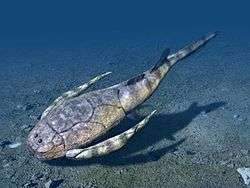Megatherium
Megatherium (/mɛɡəˈθɪəriəm/ meg-ə-THEER-ee-əm from the Greek mega [μέγας], meaning "great", and therion [θηρίον], "beast") is an extinct genus of ground sloths endemic to South America that lived from the Early Pliocene[1] through the end of the Pleistocene.[3] It is best known for the elephant-sized type species M. americanum, sometimes called the giant ground sloth, or the megathere, native to the Pampas region during the Pleistocene. Various other smaller species belonging to the subgenus Pseudomegatherium are known from the Andes. Megatherium is part of the sloth family Megatheriidae, which also includes the similarly elephantine Eremotherium, which was native to tropical South America and southern North America. Only a few other land mammals equaled or exceeded M. americanum in size, such as large proboscideans (e.g., elephants) and the giant rhinoceros Paraceratherium. Megatherium was first discovered in 1788 on the bank of the Luján River in Argentina. The holotype specimen was then shipped to Spain the following year wherein it caught the attention of the esteemed paleontologist Georges Cuvier, who was the first to determine, by means of comparative anatomy, that Megatherium was a sloth.[4] Megatherium became extinct around 12,000 years ago during the Quaternary extinction event, which also claimed most other large mammals in the New World. The extinction coincides with the settlement of the Americas, and a kill site where a M. americanum was slaughtered and butchered is known, suggesting that hunting could have caused its extinction.[5]
| Megatherium | |
|---|---|
| M. americanum skeleton, Natural History Museum, London | |
| Scientific classification | |
| Kingdom: | Animalia |
| Phylum: | Chordata |
| Class: | Mammalia |
| Order: | Pilosa |
| Family: | †Megatheriidae |
| Subtribe: | †Megatheriina |
| Genus: | †Megatherium Cuvier, 1796 |
| Type species | |
| †Megatherium americanum Cuvier, 1796 | |
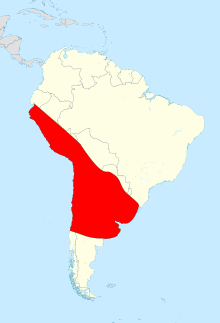 | |
| Map showing the distribution of Megatherium in red, inferred from fossil finds | |
| Synonyms[2] | |
| |
Description
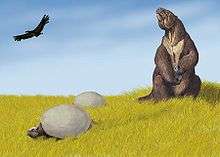
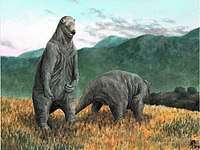
Megatherium americanum is one of the largest land mammals known to have existed, weighing up to 4 t (4.4 short tons)[6] and measuring up to 6 m (20 ft) in length from head to tail.[7][8] It is the largest-known ground sloth, as big as modern elephants, and would have only been exceeded in its time by a few species of mammoth. Megatherium species were members of the abundant Pleistocene megafauna, large mammals that lived during the Pleistocene epoch.
It had a robust skeleton with a large pelvic girdle and a broad muscular tail. Its large size enabled it to feed at heights unreachable by other contemporary herbivores. Rising on its powerful hind legs and using its tail to form a tripod, Megatherium could support its massive body weight while using the curved claws on its long forelegs to pull down branches with the choicest leaves. This sloth, like a modern anteater, walked on the sides of its feet because its claws prevented it from putting them flat on the ground. Although it was primarily a quadruped, its trackways show that it was capable of bipedal locomotion. Biomechanical analysis also suggests it had adaptations to bipedalism.[9]
According to one study, Megatherium was probably mostly hairless (like modern elephants) due to its large size giving it a small surface-area-to-volume ratio, making it susceptible to overheating.[10]
Mouth
Megatherium had a narrow, cone-shaped mouth and prehensile lips that were probably used to select particular plants and fruits.[11] Megatherium also possessed the narrowest muzzle of all ground sloths from the Pleistocene, possibly meaning it was a very selective eater, able to carefully pick and choose which leaves and twigs to consume.[11] While some evidence suggests the animal could use its tongue to differentiate and select its foliage, the lips probably had a more important role in this.[12] In Megatherium, the stylohyal and epihyal bones (parts of the hyoid bone which supports the tongue and is located in the throat) were fused together, and the apparatus lies farther upwards the throat, which, together with the elongated, steeply inclined mandibular symphysis, indicates a relatively shorter geniohyoid muscle and thus more limited capacity for tongue protrusion.[13] Analysis of wear and the biomechanics of the chewing muscles suggests that they chewed vertically. Megatheres displayed deeper jaws than other sloths.[6]
Like other sloths, Megatherium lacked the enamel, deciduous dentition, and dental cusp patterns of other mammals. Instead of enamel, the tooth displays a layer of cementum, orthodentine, and modified orthodentine, creating a soft, easily abraded surface.[12] The teeth of M. americanum exhibit extreme hypsodonty, indicative of its gritty, fibrous diet. Their teeth in side view show interlocking V-shaped biting surfaces, though they are nearly square in cross-section and exhibit bilophodonty. The teeth are spaced equidistantly in a series, located in the back of the mouth, which leaves space at the predentary; there is no diastema, though the length of this tooth row and of the predentary spout can vary by species.[6]
Taxonomy
Megatherium is divided into 2 subgenera, Megatherium and Pseudomegatherium. Taxonomy according to Pujos (2006):[14]
- Subgenus Megatherium
- †M. altiplanicum Saint-André & de Iuliis 2001
- †M. americanum Cuvier 1796
- Subgenus Pseudomegatherium Kraglievich 1931
- †M. celendinense Pujos 2006
- †M. medinae Philippi 1893
- †M. sundti Philippi 1893
- †M. urbinai Pujos & Salas 2004

The first fossil specimen of Megatherium was discovered in 1788 by Manuel Torres, on the bank of the Luján River in Argentina. The fossil was shipped to Museo Nacional de Ciencias Naturales in Madrid the following year, where it remains. It was reassembled by museum employee Juan Bautista Bru, who also drew the skeleton and some individual bones.[15]
Based on Bru's illustrations, comparative anatomist Georges Cuvier determined the relationships and appearance of Megatherium. He published his first paper on the subject in 1796, a transcript of a previous lecture at the French Academy of Sciences. He published on the subject again in 1804; this paper was republished in his book Recherches sur les ossemens fossiles de quadrupèdes.[4] In his 1796 paper, Cuvier assigned the fossil the scientific name Megatherium americanum. Cuvier determined that Megatherium was a sloth, and at first believed that it used its large claws for climbing trees, like modern sloths, although he later changed his hypothesis to support a subterranean lifestyle, with the claws used to dig tunnels.[4]
Fossils of Megatherium and other western megafauna proved popular with the Georgian era public until the discovery of the dinosaurs some decades later.
Since the original discovery, numerous other fossil Megatherium skeletons have been discovered across South America, in Argentina, Bolivia, Brazil, Chile, Colombia (Quipile, Cundinamarca),[16][17] Guyana, Paraguay, Peru and Uruguay.[3] New species in the genus Megatherium, M. urbinai and M. celendinense, have been described in 2004 and 2006 respectively.[18] M. celedinense is named after Celendin, Cajamarca Province in the Peruvian Andes.[14] These species are considerably smaller than M. americanum, and are considered to belong to a separate subgenus, Pseudomegatherium.[14]
The species Megatherium (Pseudomegatherium) tarijense, appears to be a junior synonym of M. americanum, and merely a small individual.[19]
The species Megatherium filholi Moreno, 1888 of the Pampas, previously thought to be a junior synonym of M. americanum representing juvenile individuals, was suggested to be a distinct valid species in 2019.[20]
Megatherium gallardoi Ameghino & Kraglievich 1921 from the Ensenadan of Argentina was suggested to be a valid species in 2008, most closely related to M. americanum and M. altiplanicum.[21]
M. parodii Hoffstetter 1949, and M. istilarti Kraglievich 1925 have not had their validity assessed in recent literature.
Evolution
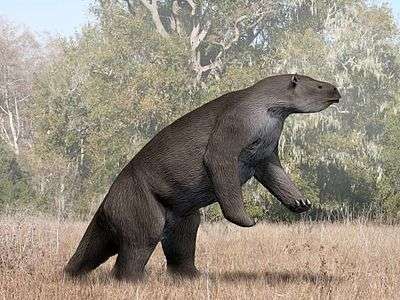
Ground sloths are a diverse group belonging to superorder Xenarthra, which also includes extinct pampatheres and glyptodonts, as well as living tree sloths, anteaters, and armadillos. One of the four major eutherian radiations, this superorder evolved in isolation in South America while it was an island continent during the Paleogene and Neogene. The family to which Megatherium belongs, Megatheriidae, is related within superfamily Megatheroidea to the extinct families Nothrotheriidae and Megalonychidae, and to living three-toed sloths of family Bradypodidae, as deduced recently from collagen[22] and mitochondrial DNA[23] sequences obtained from subfossil bones.
During the Pliocene, the Central American Isthmus formed, causing the Great American Interchange, and a mass extinction of much of the indigenous South American megafauna. Xenarthrans were largely unaffected and continued to thrive in spite of competition from the northern immigrants. Ground sloths were prominent among the various South American animal groups to migrate northwards into North America, where they remained and flourished until the late Pleistocene.[24]
The rhinoceros-sized Promegatherium of the Miocene is suggested to be the ancestor of Megatherium. The oldest (and smallest) species of Megatherium is M. altiplanicum of Pliocene Bolivia.[1] It was very similar to Promegatherium, and was also about the size of a rhinoceros. M. tarijense has been regarded as a medium-sized Megatherium species, larger than M. altiplanicum, but smaller than M. americanum. It roamed from the Tarija Basin in Bolivia to Yantac in Peru.[19] Species of Megatherium became larger over time, with the largest species, M. americanum of the Late Pleistocene, reaching the size of an African elephant. The oldest records of M. americanum are from the latter half of the Middle Pleistocene, around 0.4 Ma.[25]
Habitat
Megatherium inhabited woodland and grassland environments of the lightly wooded areas of South America, with a Late Pleistocene range centred around the Pampas[26] where it was an endemic species, as recently as 10,000 years ago. Megatherium was adapted to temperate, arid or semiarid open habitats. An example of these most recent finds is at Cueva del Milodón in Patagonian Chile.[27] The closely related genus Eremotherium (that has been classified occasionally as part of Megatherium)[28] lived in more tropical environments further north, and invaded temperate North America as part of the Great American Interchange.
Paleobiology
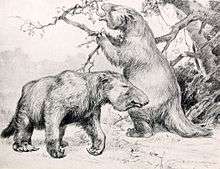
The giant ground sloth lived mostly in groups, but it may have lived singly in caves. It probably had mainly a browsing diet in open habitats, but also it probably fed on other moderate to soft tough food. For millions of years, the sloth did not have many enemies to bother it, so it was probably a diurnal animal.
The giant ground sloth was a herbivore, feeding on leaves such as yuccas, agaves, and grasses. While it fed chiefly on terrestrial plants, it could also stand on its hind legs, using its tail as a balancing tripod, and reach for upper growth vegetation. It would pull itself upright to sit on its haunches or to stand and then tugged at plants with its feet, digging them up with the five sharp claws on each foot. The sloth used its simple teeth to grind down food before swallowing it, and its highly developed cheek muscles helped in this process. The sloth's stomach was able to digest coarse and fibrous food. It is likely that it spent a lot of time resting to aid digestion.
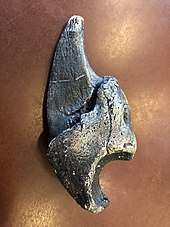
A recent morpho-functional analysis[6] indicates that M. americanum was adapted for strong vertical biting. The teeth are hypsodont and bilophodont, and the sagittal section of each loph is triangular with a sharp edge. This suggests that the teeth were used for cutting, rather than grinding, and that hard fibrous food was not the primary dietary component.
While it has been suggested that the giant sloth may have been partly carnivorous, this is a controversial claim. Richard Fariña and Ernesto Blanco of the Universidad de la República in Montevideo have analysed a fossil skeleton of M. americanum and discovered that its olecranon—the part of the elbow to which the triceps muscle attaches—was very short. This adaptation is found in carnivores and optimises speed rather than strength. The researchers say this would have enabled M. americanum to use its claws like daggers. They suggest that to add nutrients to its diet, Megatherium may have taken over the kills of Smilodon. Based on the estimated strength and mechanical advantage of its biceps, it has been proposed that Megatherium could have overturned adult glyptodonts (large, armored xenarthrans, related to armadillos) as a means of scavenging or hunting these animals.[29] However, noting that sloths lack the carnassials typical of predators and that traces of bone are absent from the many preserved deposits of sloth dung, Paul Martin has described this proposal as "fanciful".[upper-alpha 1] Carbon isotope analysis has found that Megatherium has isotope values similar to other megafaunal herbivores such as mammoths, glyptodonts, and Macrauchenia, and significantly unlike omnivorous and carnivorous mammals, suggesting that Megatherium was an obligate herbivore.[30]
Extinction
In the south, the giant ground sloth flourished until about 10,500 radiocarbon years BP (8,500 BC). Most cite the appearance of an expanding population of human hunters as the cause of its extinction.[31] There are a few late dates of around 8,000 BP and one of 7,000 BP[32] for Megatherium remains, but the most recent date viewed as credible is about 10,000 BP.[33] The use of bioclimatic envelope modeling indicates that the area of suitable habitat for Megatherium had shrunk and become fragmented by the mid-Holocene. While this alone would not likely have caused its extinction, it has been cited as a possible contributing factor.[34] Two M. americanum bones, a ulna[35] and atlas vertebra[25] from separate collections, bear cut marks suggestive of butchery, with the latter suggested to represent an attempt to exploit the contents of the head.[25] A kill site dating to around 12,600 BP is known from Campo Laborde in the Pampas in Argentina, where a single individual of M. americanum was slaughtered and butchered, which is the only confirmed giant ground sloth kill site in the Americas. The study also questioned the Holocene dates previously obtained for Pampas megafauna, suggesting that they were due to humic acid contamination.[5]
See also
Notes
- Martin (2005), p. 35
References
- Saint-André, P. A.; De Iuliis, G. (2001). "The smallest and most ancient representative of the genus Megatherium Cuvier, 1796 (Xenarthra, Tardigrada, Megatheriidae), from the Pliocene of the Bolivian Altiplano" (PDF). Geodiversitas. 23 (4): 625–645. Archived from the original (PDF) on 2013-10-29. Retrieved 14 April 2016.
- Megatherium at fossilworks.org (retrieved 19 May 2020)
- Zurita, A. E.; Carlini, A. A.; Scillato-Yané, G. J.; Tonni, E. P. (2004). "Mamíferos extintos del Cuaternario de la Provincia del Chaco (Argentina) y su relación con aquéllos del este de la región pampeana y de Chile". Revista Geológica de Chile. 31 (1): 65–87. doi:10.4067/S0716-02082004000100004.
- Argot, Christine (21 May 2008). "Changing Views in Paleontology: The Story of a Giant (Megatherium, Xenarthra)". In Sargis, E. J.; Dagosto, M. (eds.). Mammalian Evolutionary Morphology: A Tribute to Frederick S. Szalay. Springer. pp. 37–50. ISBN 978-1-4020-6997-0. OCLC 236490247.
- Politis, Gustavo G.; Messineo, Pablo G.; Stafford, Thomas W.; Lindsey, Emily L. (March 2019). "Campo Laborde: A Late Pleistocene giant ground sloth kill and butchering site in the Pampas". Science Advances. 5 (3): eaau4546. Bibcode:2019SciA....5.4546P. doi:10.1126/sciadv.aau4546. ISSN 2375-2548. PMC 6402857. PMID 30854426.
- Bargo, M. S. (2001). "The ground sloth Megatherium americanum: Skull shape, bite forces, and diet" (PDF). Acta Palaeontologica Polonica. 46 (2): 173–192. Retrieved 22 July 2012.
- "Megatherium Wildfacts". BBC. Archived from the original on February 1, 2014. Retrieved 22 July 2012.
- Haines, T.; Chambers, P. (2007). The Complete Guide to Prehistoric Life. Italy: Firefly Books Ltd. pp. 192–193. ISBN 978-1-55407-181-4.
- Casinos, A. (1996). "Bipedalism and quadrupedalism in Megatherium: An attempt at biomechanical reconstruction". Lethaia. 29: 87–96. doi:10.1111/j.1502-3931.1996.tb01842.x.
- Fariña, R. (June 2002). "Megatherium, the hairless: appearance of the great Quaternary sloths (Mammalia;Xenarthra)". Ameghiniana. 39 (2): 241–244 – via ResearchGate.
- Bargo, M. S.; Toledo, N.; Vizcaíno, S. F. (2006). "Muzzle of South American Pleistocene ground sloths (Xenarthra, Tardigrada)". Journal of Morphology. 267 (2): 248–263 (see p. 260). doi:10.1002/jmor.10399. PMID 16315216.
- Ferigolo, J. (1985). "Evolutionary trends of the histological pattern in the teeth of Edentata (Xenarthra)". Archives of Oral Biology. 30 (1): 71–82. doi:10.1016/0003-9969(85)90027-5. ISSN 0003-9969. PMID 3857888.
- Perez, L. M.; Toledo, N.; De Lullis, G.; Bargo, M. S.; Vizcaino, S. F. (2010). "Morphology and Function of the Hyoid Apparatus of Xenarthran Fossils (Mammalia)". Journal of Morphology. 271 (9): 1119–1133. doi:10.1002/jmor.10859. PMID 20730924.
- Pujos, François (2006). "Megatherium celendinense sp. nov. from the Pleistocene of the Peruvian Andes and the phylogenetic relationships of Megatheriines". Palaeontology. 49 (2): 285–306. doi:10.1111/j.1475-4983.2006.00522.x.
- Piñero, J. M. L. (Spring 1988). "Juan Bautista Bru (1740–1799) and the description of the genus Megatherium". Journal of the History of Biology. 21 (1): 147–163. doi:10.1007/BF00125797.
- Bürgl, Hans (1956). "Restos de Megatherium y otros fósiles de Quipile, Cundinamarca". INGEOMINAS: 1–14. Retrieved 2017-05-03. Cite journal requires
|journal=(help) - De Porta, Jaime (1961). "La posición estratigráfica de la fauna de Mamíferos del pleistoceno de la Sabana de Bogotá". Boletín de Geología, Universidad Industrial de Santander. 7: 37–54. Retrieved 2017-05-03.
- Pujos, François; Salas, Rodolfo (2004). "A new species of Megatherium (Mammalia: Xenarthra: Megatheriidae) from the Pleistocene of Sacaco and Tres Ventanas, Peru". Palaeontology. 47 (3): 579–604. doi:10.1111/j.0031-0239.2004.00376.x.
- De Iuliis, G.; Pujos, F.; Tito, G. (2009). "Systematic and taxonomic revision of the Pleistocene ground sloth Megatherium (Pseudomegatherium) tarijense (Xenarthra: Megatheriidae)". Journal of Vertebrate Paleontology. 29 (4): 1244–1251. doi:10.1671/039.029.0426. JSTOR 20627134.
- Agnolin, Federico L.; Chimento, Nicolás R.; Brandoni, Diego; Boh, Daniel; Campo, Denise H.; Magnussen, Mariano; De Cianni, Francisco (2018-09-01). "New Pleistocene remains of Megatherium filholi Moreno, 1888 (Mammalia, Xenarthra) from the Pampean Region: Implications for the diversity of Megatheriinae of the Quaternary of South America". Neues Jahrbuch für Geologie und Paläontologie - Abhandlungen. 289 (3): 339–348. doi:10.1127/njgpa/2018/0777. ISSN 0077-7749.
- Brandoni, Diego; Soibelzon, Esteban; Scarano, Alejo Carlos (December 2008). "On Megatherium gallardoi (Mammalia, Xenarthra, Megatheriidae) and the Megatheriinae from the Ensenadan (lower to middle Pleistocene) of the Pampean region, Argentina". ISSN 1280-9659. Cite journal requires
|journal=(help) - Presslee, S.; Slater, G. J.; Pujos, F.; Forasiepi, A. M.; Fischer, R.; Molloy, K.; Mackie, M.; Olsen, J. V.; Kramarz, A.; Taglioretti, M.; Scaglia, F.; Lezcano, M.; Lanata, J. L.; Southon, J.; Feranec, R.; Bloch, J.; Hajduk, A.; Martin, F. M.; Gismondi, R. S.; Reguero, M.; de Muizon, C.; Greenwood, A.; Chait, B. T.; Penkman, K.; Collins, M.; MacPhee, R.D.E. (2019). "Palaeoproteomics resolves sloth relationships". Nature Ecology & Evolution. 3 (7): 1121–1130. doi:10.1038/s41559-019-0909-z. PMID 31171860.
- Delsuc, F.; Kuch, M.; Gibb, G. C.; Karpinski, E.; Hackenberger, D.; Szpak, P.; Martínez, J. G.; Mead, J. I.; McDonald, H. G.; MacPhee, R.D.E.; Billet, G.; Hautier, L.; Poinar, H. N. (2019). "Ancient Mitogenomes Reveal the Evolutionary History and Biogeography of Sloths". Current Biology. 29 (12): 2031–2042.e6. doi:10.1016/j.cub.2019.05.043. PMID 31178321.
- Martin, P. S. (2005). Twilight of the Mammoths: Ice Age Extinctions and the Rewilding of America (Illustrated ed.). University of California Press. ISBN 978-0520231412. OCLC 58055404. Retrieved 11 September 2014.CS1 maint: ref=harv (link)
- Autoecologia Humana del Quaternari Departament d'Història i Història de l'Art Universitat Rovira i Virgili Martínez-Navarro, B.; Chichkoyan, K.V.; Moigne, A.-M.; Cioppi, E.; Belinchón, M.; Lanata, J.L. (2017). Description and interpretation of a Megatherium americanum atlas with evidence of human intervention. Rivista Italiana di Paleontologia e Stratigrafia. OCLC 1084743779.CS1 maint: multiple names: authors list (link)
- McKenna, M. C.; Bell S. K. (1997). Classification of Mammals Above the Species Level'. New York: Columbia University Press. p. 631. ISBN 978-0231110129.
- C. Michael Hogan (2008) Cueva del Milodon, Megalithic Portal
- Cisneros, J. C. (2005). "New Pleistocene vertebrate fauna from El Salvador". Revista Brasileira de Paleontologia. 8 (3): 239–255. doi:10.4072/rbp.2005.3.09. Retrieved 2014-05-27.
- Fariña, R. A.; R. E. Blanco (1996). Megatherium, the stabber. Proceedings of the Royal Society of London. 263. pp. 1725–1729. doi:10.1098/rspb.1996.0252. ISBN 9780520231412. PMID 9025315.
- Bocherens, H.; Cotte, M.; Bonini, R.A.; Straccia, P.; Scian, D.; Soibelzon, L.; Prevosti, F.J. (August 2017). "Isotopic insight on paleodiet of extinct Pleistocene megafaunal Xenarthrans from Argentina". Gondwana Research. 48: 7–14. Bibcode:2017GondR..48....7B. doi:10.1016/j.gr.2017.04.003.
- Steadman, D. W.; Martin, P. S.; MacPhee, R. D. E.; Jull, A. J. T.; McDonald, H. G.; Woods, C. A.; Iturralde-Vinent, M.; Hodgins, G. W. L. (2005-08-16). "Asynchronous extinction of late Quaternary sloths on continents and islands". Proc. Natl. Acad. Sci. USA. 102 (33): 11763–11768. Bibcode:2005PNAS..10211763S. doi:10.1073/pnas.0502777102. PMC 1187974. PMID 16085711.
- Turvey, Sam (2009). Holocene extinctions. Oxford University Press. p. 24. ISBN 978-0-19-953509-5.
- Fiedal, Stuart (2009). "Sudden Deaths: The Chronology of Terminal Pleistocene Megafaunal Extinction". In Haynes, Gary (ed.). American Megafaunal Extinctions at the End of the Pleistocene. Vertebrate Paleobiology and Paleoanthropology. Springer. pp. 21–37. doi:10.1007/978-1-4020-8793-6_2. ISBN 978-1-4020-8792-9.
- Lima-Ribeiro, Matheus Souza; et al. (December 2012). "Potential Suitable Areas of Giant Ground Sloths Dropped Before its Extinction in South America: the Evidences from Bioclimatic Envelope Modeling". Natureza & Conservação. 10 (2): 145–151. doi:10.4322/natcon.2012.022.
- Chichkoyan, Karina V.; Martínez-Navarro, Bienvenido; Moigne, Anne-Marie; Belinchón, Margarita; Lanata, José L. (June 2017). "The exploitation of megafauna during the earliest peopling of the Americas: An examination of nineteenth-century fossil collections". Comptes Rendus Palevol. 16 (4): 440–451. doi:10.1016/j.crpv.2016.11.003.
External links
| Wikimedia Commons has media related to Megatherium. |
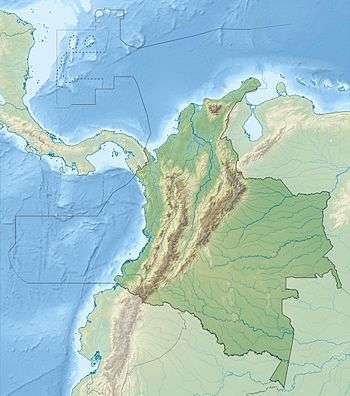
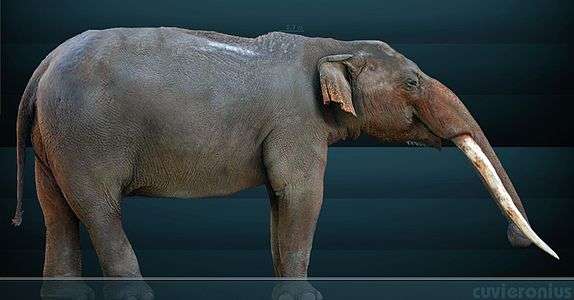
.jpg)
